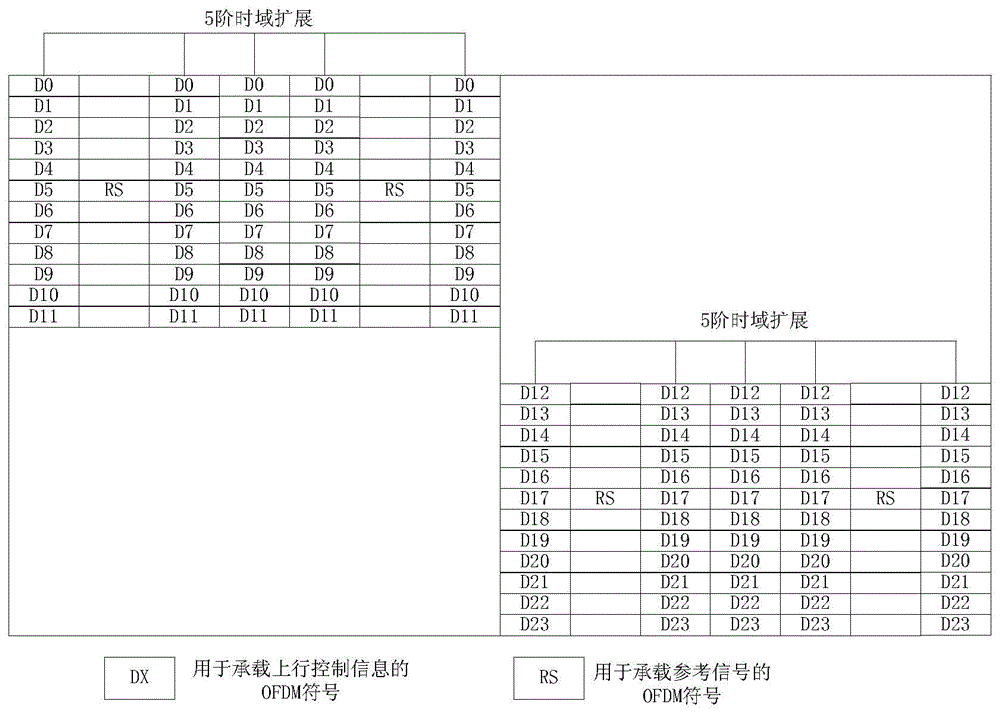Uplink control information transmission method and device
A technology for controlling information and sending method, applied in the field of communication
- Summary
- Abstract
- Description
- Claims
- Application Information
AI Technical Summary
Problems solved by technology
Method used
Image
Examples
Embodiment 1
[0249]In an application scenario that supports aggregation of up to 32 carriers, a new PUCCH format is required to support a large number of HARQ-ACK feedbacks. In this optional embodiment, it is called PUCCH format 4. The new PUCCH format can contain one or more It depends on whether the new PUCCH format is designed according to the maximum number of HARQ-ACK bits that the system needs to support, or according to the current HARQ-ACK that needs to be fed back. Wherein, the design of the new PUCCH format mainly includes: the design of the channel coder and the design of the reference signal structure. The following formats are included in the optional implementation manner of this optional embodiment:
[0250] PUCCH format 4-1: PUCCH format 3 of multiple OCC codes. PUCCH format 3 in the related art implements inter-code multiplexing between terminals through OCC codes. If a terminal is allowed to occupy multiple OCC codes, it is equivalent to a terminal using multiple PUCCH f...
Embodiment 2
[0263] When the terminal uses a PUCCH format to send HARQ-ACK, it needs to determine its corresponding PUCCH resource. In related protocols, the resources of PUCCH format 1a / 1b and PUCCH format 3 used to send HARQ-ACK are determined as follows:
[0264] For the PUCCH format 1a / 1b, there are two resource determination methods, implicit mapping and high layer configuration Joint Power Transmission Command (TPC) control field indication. For the PDSCH of the corresponding PDCCH / EPDCCH or the PDCCH / EPDCCH of the semi-persistent persistent scheduling release (SPS release), the corresponding PUCCH resource and the minimum index of the CCE / ECCE corresponding to the PDCCH / (e)PDCCH have an implicit For the PDSCH with semi-persistent scheduling, the corresponding PUCCH resources are determined according to the TPC indication field in the DCI of the PDSCH with semi-persistent scheduling activated and the PUCCH resources configured by higher layers.
[0265] For PUCCH format 3, the corre...
Embodiment 3
[0271] It can be seen from Embodiment 1 that there are many new PUCCH formats 4, even if they are the same format, the frequency domain or code domain resources occupied by them may be different, which depends on the number of bits of the fed back HARQ-ACK, Or the performance of the HARQ-ACK to be satisfied is different.
[0272] For related protocols, the number of HARQ-ACK bits that need to be fed back is determined according to the number of configured serving cells and the transmission mode of the configured serving cells. For TDD systems, it also needs to be determined according to the configured uplink and downlink ratios. For TDD serving cell aggregation with row matching, or for TDD-FDD aggregation where TDD is the main serving cell scenario, it also needs to be determined according to the configured downlink reference uplink and downlink configuration. In the scenario where a maximum of 32 serving cells are aggregated, the number of configured serving cells may be rel...
PUM
 Login to View More
Login to View More Abstract
Description
Claims
Application Information
 Login to View More
Login to View More - R&D
- Intellectual Property
- Life Sciences
- Materials
- Tech Scout
- Unparalleled Data Quality
- Higher Quality Content
- 60% Fewer Hallucinations
Browse by: Latest US Patents, China's latest patents, Technical Efficacy Thesaurus, Application Domain, Technology Topic, Popular Technical Reports.
© 2025 PatSnap. All rights reserved.Legal|Privacy policy|Modern Slavery Act Transparency Statement|Sitemap|About US| Contact US: help@patsnap.com



